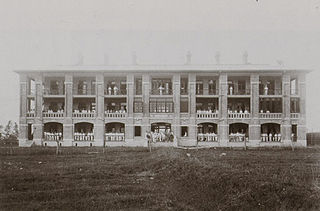
Gansu is a province in Northwest China. Its capital and largest city is Lanzhou, in the southeast part of the province.

Lanzhou is the capital and largest city of the Chinese province of Gansu, located in the northwest of the country. Located on the banks of the Yellow River, it is a key regional transportation hub, connecting areas further west by rail to the eastern half of the country. Historically, it has been a major link on the Northern Silk Road and it stands to become a major hub on the New Eurasian Land Bridge. The city is also a center for heavy industry and petrochemical industry.

Lingnan University in Guangzhou (Canton), China, was a private university established by a group of American missionaries in 1888. At its founding it was named Canton Christian College (格致書院).

Wuhu is a prefecture-level city in southeastern Anhui province, China. Sitting on the southeast bank of the Yangtze River, Wuhu borders Xuancheng to the southeast, Chizhou and Tongling to the southwest, Hefei City to the northwest, Ma'anshan city to the northeast, Jiangsu to the east, and is approximately 90 km (56 mi) southwest of Nanjing. With the urbanization trend in the southern part of Nanjing, a conurbation between Nanjing, Maanshan and Wuhu is in building with more than 10,660,000 inhabitants.

The Lanzhou−Xinjiang railway or Lanxin railway, is the longest railway in Northwestern China. It runs 1904 kilometres from Lanzhou, Gansu, through the Hexi Corridor, to Ürümqi, in Xinjiang. It was Xinjiang's only rail link with the rest of China until the opening of the Lanzhou–Xinjiang high-speed railway in December 2014. The railway follows the path of the ancient Silk Road.

Zhangye, formerly romanized as Changyeh or known as Kanchow, is a prefecture-level city in central Gansu Province in the People's Republic of China. It borders Inner Mongolia on the north and Qinghai on the south. Its central district is Ganzhou, formerly a city of the Western Xia and one of the most important outposts of western China.

William Whiting Borden was an American philanthropist and millionaire Christian missionary candidate who died in Egypt before reaching his chosen field, Gansu province in China.

The People's Liberation Army General Hospital and Medical School is the central military medical institution of the People's Liberation Army and the largest comprehensive military hospital in China.
Medical missions in China by Catholic and Protestant physicians and surgeons of the 19th and early 20th centuries laid many foundations for modern medicine in China. Western medical missionaries established the first modern clinics and hospitals, provided the first training for nurses, and opened the first medical schools in China. Work was also done in opposition to the abuse of opium. Medical treatment and care came to many Chinese who were addicted, and eventually public and official opinion was influenced in favor of bringing an end to the destructive trade. By 1901, China was the most popular destination for medical missionaries. The 150 foreign physicians operated 128 hospitals and 245 dispensaries, treating 1.7 million patients. In 1894, male medical missionaries comprised 14 percent of all missionaries; women doctors were four percent. Modern medical education in China started in the early 20th century at hospitals run by international missionaries.

The Second Affiliated Hospital of Zhejiang University School of Medicine, known as Kwang Chi Hospital before 1952, is a non-for-profit tertiary care public hospital in Hangzhou, Zhejiang, China. Founded as a drug rehabilitation clinic in 1869 by the British Church Missionary Society, it is one of the oldest hospitals in Zhejiang to offer Western medicine and one of the leading medical centres in China.

The Longhai railway, formerly romanized as the Lunghai railway, is a major arterial east–west railway in China. It runs from Lianyungang, Jiangsu, on the Yellow Sea to Lanzhou, Gansu, through the provinces of Jiangsu, Anhui, Henan, Shaanxi, and Gansu, covering a total length of 1,759 kilometres (1,093 mi). The line is named after Gansu, also known as Long (陇) in Chinese and Lianyungang's previous name, Haizhou. The Longhai Line is one of the busiest Chinese railways. It has dual tracks throughout and electrification was completed in 2009.
Zhejiang Provincial College of Medicine, was a medical college for higher education in Hangzhou, Zhejiang Province, China. It was one of main roots for the current School of Medicine, Zhejiang University (浙江大學醫學院/浙江大学医学院).

Chinese General Hospital and Medical Center (CGHMC), also known as the Chinese General Hospital, is a district general hospital and teaching hospital in Manila, Philippines. It is one of the oldest hospitals in the Philippines, founded during the Spanish occupation of the country from donations of Chinese immigrants. The hospital's operations is supported by the Philippine Chinese Charitable Association (PCCA), founded in 1878 when the Chinese community was established in Manila.

Lee Sun Chau was one of the first female Chinese doctors of Western Medicine in China.

The Obstetrics and Gynecology Hospital of Fudan University, commonly known as the Red House Hospital, is a teaching hospital in Shanghai, China, affiliated with the Shanghai Medical College of Fudan University. It is rated Grade 3, Class A, the highest rating in the Chinese medical system.

Huoshenshan Hospital was an emergency specialty field hospital, built between 23 January and 2 February 2020, in response to the COVID-19 pandemic in China. The facility is located near Zhiyin Lake (知音湖) in the Caidian District, Wuhan, Hubei, China, next to the Wuhan Workers' Sanatorium (武汉职工疗养院), and is designed to treat people with COVID-19. The hospital has run under the jurisdiction and management of the People's Liberation Army since its completion. A second field hospital, Leishenshan Hospital, using the same design, opened on 8 February, A further sixteen other temporary treatment facilities were set up in converted buildings in Wuhan for isolation and treatment of COVID-19 cases. Huoshenshan and Leishenshan hospitals were closed on 15 April after community transmission stopped in China, almost a month after the other temporary facilities had been closed.
Ai Fen is a Chinese doctor and director of the emergency department of Central Hospital of Wuhan. In December 2019, she was one of the first doctors to encounter pneumonia patients infected with the then-unknown virus, SARS-CoV-2. On 30 December 2019, Ai Fen received a diagnostic report of suspected "Severe Acute Respiratory Syndrome cases". An image of the diagnostic report was shared on WeChat by an ophthalmologist at the hospital, Li Wenliang. The image was then circulated on the internet, leading Ai Fen to be questioned by hospital superiors. She was given the nickname "The Whistle-Giver" (发哨子的人) in an article in the Chinese Renwu magazine which was censored by the Chinese government but was reposted on the Chinese internet using emojis, Morse code and pinyin to circumvent censorship.

The Beijing Xiaotangshan Recovery Hospital, also known as the Beijing Xiaotangshan Hospital, is a tertiary-level general hospital in Xiaotangshan Township, Changping District, Beijing, China, occupying approximately 33 hectares of land.















